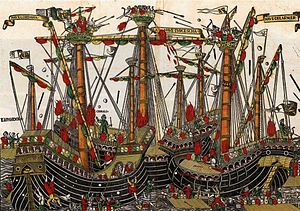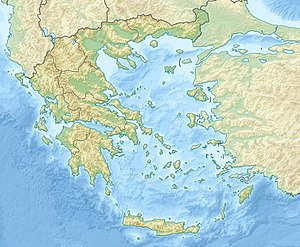Ottoman–Venetian War (1499–1503)
| Second Ottoman–Venetian War | |||||||||
|---|---|---|---|---|---|---|---|---|---|
| Part of the Ottoman–Venetian Wars | |||||||||
 The Battle of Zonchio | |||||||||
| |||||||||
| Belligerents | |||||||||
|
Castile and Aragon |
| ||||||||
| Commanders and leaders | |||||||||
|
Gonzalo de Córdoba |
Feriz Beg | ||||||||
The Second Ottoman–Venetian War was fought from 1499 to 1503 between the Ottoman Empire and the Republic of Venice for control of contested lands in the Aegean Sea, the Ionian Sea and the Adriatic Sea.
The Ottomans, under the command of Admiral Kemal Reis, were victorious and forced the Venetians to recognise their gains at the end of the war.
The war
1499
In January 1499, Kemal Reis set sail from
Ottoman incursions into inland Dalmatia also started in 1499,
1500
In December 1499, the Venetians attacked
1501–1503
The Ottoman incursions in Dalmatia escalated to the point where Venice was forced to sign a treaty with
By the end of 1502, Venice and the Ottoman Empire agreed on an armistice.[1] On 31 January 1503, Venice signed another treaty with Vladislaus II, having already paid 124,000 ducats through the previous treaty, to pay 30,000 ducats a year for the same purpose.[1]
In 1503, Turkish cavalry raids reached Venetian territory in Northern Italy, and Venice was forced to recognize the Ottoman gains, ending the war.
The economy of the Venetian cities in Dalmatia was severely impacted by the Turkish occupation of the hinterland during this war.[4]
Aftermath
By September 1510, Vladislaus had received a total of 116,000 ducats under the terms of the second treaty with Venice.[1] After 1508, he had also been under pressure from the League of Cambrai to join them against Venice, but skillful Venetian diplomacy prevented that.[1]
See also
References
- ^ ISSN 0582-673X. Retrieved 2012-07-08.
- ^ Goodwin 2013, p. 104.
- ^ Press 1948, p. 80.
- ISSN 0353-295X. Retrieved 2012-07-08.
Sources
- Chasiotis, Ioannis (1974). "Πολεμικές συγκρούσεις στον ελληνικό χώρο και η συμμετοχή των Ελλήνων" [Conflicts in the Greek lands and the participation of the Greeks]. Ιστορία του Ελληνικού Έθνους, Τόμος Ι′: Ο ελληνισμός υπό ξένη κυριαρχία, 1453–1669 [History of the Greek Nation, Volume X: Hellenism under foreign rule, 1453–1669] (in Greek). Athens: Ekdotiki Athinon. pp. 252–323.
- Illinois Studies in the Social Sciences. University of Illinois Press. 1948.
- Goodwin, Godfrey (2013). The Janissaries. Saqi Essentials. ISBN 978-0-86356-781-0.

